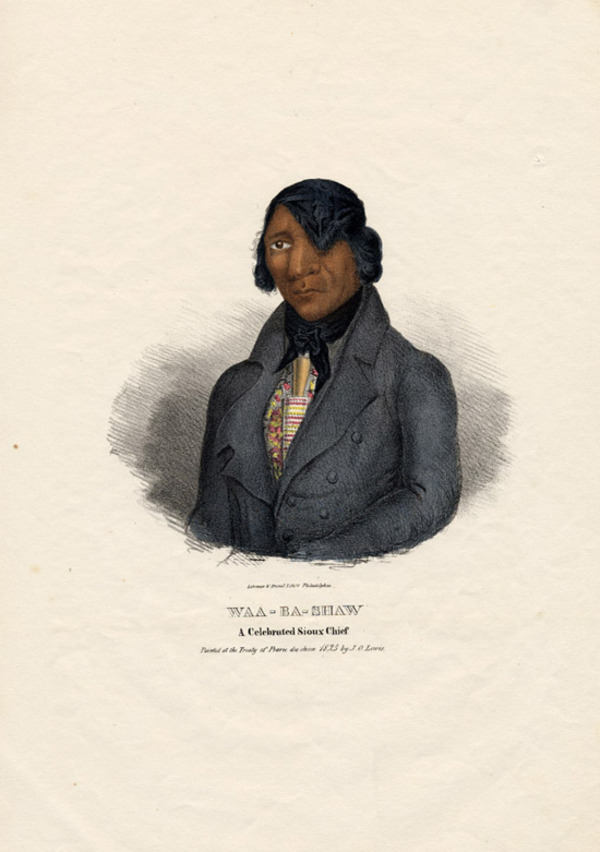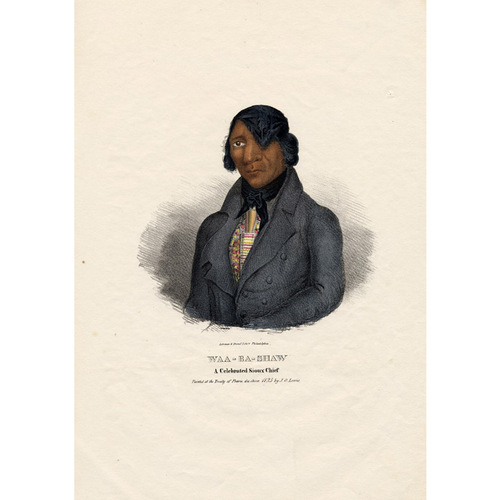
Source: Link
WAHPASHA (Wabasha, Wapasha, Ouabachas, La Feuille, La Oja; the name means red leaf), a civil chief of the Mdewakanton band of the Santee Sioux; probably b. c. 1720; probably d. before 1805. He had at least one son, Wahpasha, and one daughter, Mar-pi-ya-ro-to-win (Grey Cloud), who became the wife of James Aird.
In March 1740 Wahpasha and Ninsotin met Paul Marin* de La Malgue at the Rock River (Ill./Wis.) “to deliver up our bodies” in apology for the recent killing of two Ottawas, allies of France, by a party of Sioux. The attack, which had taken place at the Wisconsin portage (near Portage, Wis.), had been provoked by rumours that two Sioux envoys sent to Montreal about 1738 had died at the hands of the French. Leaders of the tribe, however, recognized the need for good relations with France; since the 1730s the Sioux had been warring with the Ojibwas, who were pressing down from the north, and European goods, particularly guns and powder, were vital to the struggle. After Marin had accepted the apology, Wahpasha and Sintez, another young Sioux, accompanied him to Montreal. There Wahpasha pleaded for the improvement of trade relations. The next July, however, he was accused of killing a son of Sieur Gatineau near Fort Saint-Joseph (Niles, Mich.). He was probably at the battle of Kathio, later in the 1740s, which saw traditionally armed Sioux defeated by the French guns of the Ojibwas and driven from their villages around Mille Lacs Lake (Minn.), and he is reputed to have led a migration which finally settled at Kioxsa (Winona, Minn.) .
As long as the French controlled the Great Lakes and the western fur trade the Sioux had to maintain contact with them. With the fall of Canada in 1760 came the need for a new alliance. In 1763 James Gorrell*, the British commandant at La Baye (Green Bay, Wis.), met with 12 Sioux who, offering him command of their warriors, told him of their hatred of the Ojibwas, expressed a desire for British trade goods, and said they hoped to return the next year with their “king.” This king was probably Wahpasha. In the following years Wahpasha must have cemented his ties with the new imperial power, for by the outbreak of the American revolution the British considered him an important ally.
Ordered to recruit the Indians of the upper Mississippi for the British, trader Charles Gautier de Verville contacted Wahpasha late in the winter of 1777–78. In March the chief reached Gautier’s camp at the mouth of the St Croix River (Wis.) with 20 men and together they went up the Mississippi to gather others. By June the party, consisting of more than 200 warriors of various nations and their families, had arrived at La Baye, and shortly afterwards it continued on to Montreal. Whether or not Wahpasha accompanied it east is unknown.
In the late winter or early spring of 1779 Wahpasha set out to join Henry Hamilton* at Vincennes (Ind.) but stopped at Prairie du Chien (Wis.) when he heard of Hamilton’s surrender. He sent his son to Fort Michilimackinac (Mackinaw City, Mich.) to ask for instructions and suggested an attack on the Sauks and Foxes, who had treated with the Americans. Commandant Arent Schuyler DePeyster*, fearing the effect an intertribal war would have on the British effort in the west, sent Wahpasha gifts and probably counselled him against attacks on the offending tribes. Governor Haldimand called the chief’s proposal a “very uncommon one from an Indian” and added that “the zeal he has manifested merits our attention.”
Spain’s entry into the conflict opened a new front, and early in 1780 the British urged Wahpasha to attack Spanish territory. That April at Prairie du Chien the chief received a commission as a “general” and was reported “well contented” with it. In May he and Emmanuel Hesse set out with some traders and a number of Indians as one part of a large expedition against Spanish St Louis (Mo.) [see Patrick Sinclair]. This campaign marked a high point in Sioux–Ojibwa relations, with Wahpasha and Madjeckewiss, an Ojibwa chief, both promoting unity. By June Wahpasha had evidently returned to Michilimackinac since in that month he left the post with trader John Long* for Prairie du Chien, where furs had been held for safekeeping. Before the year was out he again visited Michilimackinac, receiving gifts for his people.
The alliance among the western Indians that the British had encouraged was tenuous at best. In February 1783 a trader was killed in the cross-fire between one of Wahpasha’s war parties and some Ojibwas. Trade to the upper Mississippi was suspended and a council was held at Prairie du Chien on 24 May. The Foxes hastened to blame Wahpasha. He in turn assured the British that the “bad men who have killed the Whites” would be sent for justice and he asked that trade be re-established. By 1786, however, warfare was general among the western Indians. Wahpasha probably played a leading role, and in July 1787 he attended the conference arranged by the British and held at Fort Michilimackinac (by then on Mackinac Island, Mich.) [see Joseph-Louis Ainsse]. After making peace with one another, the Indians signed a treaty with the whites. They promised not to molest the traders and agreed to pay their debts, render up the killers of whites, and report those who would disturb their loyalty to the king. Wahpasha was one of the signatories.
Tradition has it that Wahpasha was expelled from his tribe because of internal jealousies and spent his last days on the Hoka River (Root River, Minn.). American explorer Zebulon Montgomery Pike conferred on the Mississippi in 1805 with his son Wahpasha, and the fact that the young chief had taken his father’s name suggests that the old chief had died by that date.
It has been claimed that Wahpasha was the first hereditary civil chief of the Sioux. According to this story Wahpasha travelled to Quebec some time after the conquest to plead for resumption of the commerce that had been withdrawn when a Sioux killed a trader near Mendota (Minn.). The British, impressed by the chief’s earnestness, gave him a medal which became a symbol of his authority and served to establish the position of civil chief, which became hereditary. The tale no doubt results from the compressive effect of oral tradition. There is no documentary evidence that Wahpasha visited Quebec during the British régime and, although the existence of hereditary positions in Sioux society before white contact is difficult to establish, they were certainly present by the 1760s. It is true, however, that Wahpasha owed much of his prestige, which he passed on to his son, to his ties with the French and British. His authority was based not only on his fighting skills but on his ability to command the presents so vital to his people’s livelihood. In turn this authority enhanced his importance in the eyes of the whites. Sinclair called him a chief “of very singular & uncommon abilities” and declared the Sioux “a People undebauched addicted to War” and “accustomed to all the attention and obedience required by discipline.” The ability to raise 200 such warriors with ease gave Wahpasha a strong bargaining position in his dealings with the whites. For a brief period the Sioux were able to exploit to their own advantage the conflicting imperial designs of the French, British, and Americans. Subsequent history has not been so kind.
BL, Add. mss 21758: ff.214–15, 220–21 (transcript at PAC). PAC, MG 19, A13, 2: 381 (transcript). Jonathan Carver, Travels through the interior parts of North-America, in the years 1766, 1767, and 1768 (London, 1778; repr. Toronto, 1974), 257. [A. S. DePeyster], Miscellanies, by an officer (Dumfries, Scot., 1813). John Long, Voyages and travels of an Indian interpreter and trader . . . (London, 1791; repr. New York, 1968, and Toronto, 1971), 185–90. Mich. Pioneer Coll., 9 (1886): 382, 384, 544, 548, 568; 11 (1887): 483–93; 23 (1893): 606–8. New light on early hist. of greater northwest (Coues), 1: 273. J.-B. Perrault, “Narrative of the travels and adventures of a merchant voyageur in the savage territories of northern America . . . ,” ed. J. S. Fox, Mich. Pioneer Coll., 37 (1909–10): 538. [Z. M. Pike], The journals of Zebulon Montgomery Pike, with letters and related documents, ed. Donald Jackson (2v., Norman, Okla., 1966), 1: 93, 126; 2: 25, 211; “Pike’s explorations in Minnesota,” Minn. Hist. Soc., Coll. (St Paul), 1 (1872): 370n. Wis., State Hist. Soc., Coll., 1 (1855): 36–41; 6 (1872): 250–51; 11 (1888): 111–64; 12 (1892): 49; 17 (1906): 323, 362, 397.. ... DAB. “Haldimand collection, calendar: continuation,” PAC Report, 1886: 685, 688, 697, 703, 706, 715. Handbook of American Indians (Hodge), vol.2. The aborigines of Minnesota: a report . . . , comp. N. H. Winchell (St Paul, 1911), 532, 540–43. T. C. Blegen, Minnesota: a history of the state (Minneapolis, Minn., 1963), 21–22. Harold Hickerson, Mdewakanton band of Sioux Indians (New York and London, 1974). Thomas Hughes, Indian chiefs of southern Minnesota; containing sketches of the prominent chieftains of the Dakota and Winnebago tribes from 1825 to 1865 ([2nd ed.], Minneapolis, 1969), 21–24. W. R. Hurt, Dakota Sioux Indians (New York and London, 1974). Gontran Laviolette, The Sioux Indians in Canada (Regina, 1944), 23. R. W. Meyer, History of the Santee Sioux: United States Indian policy on trial (Lincoln, Nebr., 1967). E. D. Neill, The history of Minnesota: from the earliest French explorations to the present time (Philadelphia, 1858), 225–31. Doane Robinson, A history of the Dakota or Sioux Indians . . . (Aberdeen, S.Dak., 1904; repr. Minneapolis, 1967), 57, 64, 119–20. H. R. Schoolcraft, Historical and statistical information, respecting the history, condition and prospects of the Indian tribes of the United States . . . (6v., Philadelphia, 1851–57; repr. New York, 1969), 2: 169n., 182; 3: 613.. ... J. H. Case, “Historical notes of Grey Cloud Island and its vicinity,” Minn. Hist. Soc., Coll. (St Paul), 15 (1915): 371. L. F. Jackson, “Sioux land treaties,” N.Dak. Hist. Soc., Coll. (Bismarck), 3 (1910): 498–528. E. D. Neill, “Dakota land and Dakota life,” Minn. Hist. Soc., Coll. (St Paul), 1 (1872): 262, 290–91. C. C. Willson, “The successive chiefs named Wabasha,” Minn. Hist. Soc., Coll. (St Paul), 12 (1908): 503–12..
Cite This Article
Gus Richardson, “WAHPASHA (Wabasha, Wapasha, Ouabachas) (La Feuille, La Oja),” in Dictionary of Canadian Biography, vol. 5, University of Toronto/Université Laval, 2003–, accessed April 1, 2025, https://www.biographi.ca/en/bio/wahpasha_5E.html.
The citation above shows the format for footnotes and endnotes according to the Chicago manual of style (16th edition). Information to be used in other citation formats:
| Permalink: | https://www.biographi.ca/en/bio/wahpasha_5E.html |
| Author of Article: | Gus Richardson |
| Title of Article: | WAHPASHA (Wabasha, Wapasha, Ouabachas) (La Feuille, La Oja) |
| Publication Name: | Dictionary of Canadian Biography, vol. 5 |
| Publisher: | University of Toronto/Université Laval |
| Year of revision: | 1983 |
| Access Date: | April 1, 2025 |



